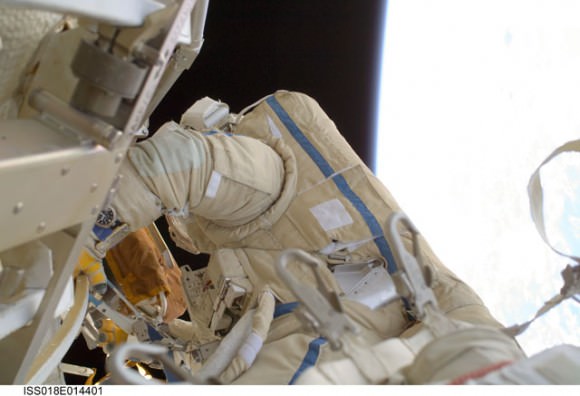[/caption] International Space Station Expedition 18 commander Mike Fincke and flight engineer Yury Lonchakov, conducted a five-hour 38-minute spacewalk on Dec. 23, successfully installing an electrical probe on the Russian Pirs airlock module designed to track down problems with Russian Soyuz capsule. They also retrieved a space exposure experiment and mounted instrumentation on the Zvezda command module that will monitor disturbances in the ionosphere. But the spacewalkers encountered problems with a second experiment package, designed to expose biological samples to the space environment, to properly plug into the station's power and data system. After extensive troubleshooting, Russian flight controllers ordered Fincke and Lonchakov to disconnect the Expose-R experiment and return it to the airlock.
Russian scientists hope data from the probe installed by Fincke will help explain malfunctions that have occurred as the Soyuz crew return module has attempted to separate from the space station.
During the past two re-entries through Earth's atmosphere in April of this year and October 2007, the Soyuz descended too steeply, leading to faster and bumpier-than-usual rides for the crews and off-target landings.
Investigators believe the Soyuz capsule detached too late because a pyrobolt — an exploding connector that keeps the module attached to the space station — failed to detonate on time.
Much of the spacewalk was devoted to arranging connectors and cables for various probes and experiments, and ensuring the reliability of telemetry from the data-gathering equipment.
[caption id="attachment_22751" align="aligncenter" width="580" caption="Yury Lonchakov during the Dec. 23 spacewalk. Credit: NASA"]
[/caption] Fincke and Lonchakov discovered a problem with the data transmission of a device they installed on a small platform outside the station's Zvezda module. The European Space Agency experiment was supposed to gather data on the effects of the space environment on a variety of materials.
They successfully placed another device on the same platform to measure the plasma environment around the station. The pair also removed a biological experiment known as Biorisk 2, which exposes biological samples to space.
It was Fincke's fifth spacewalk, Lonchakov's first and the 119th spacewalk conducted from the international space station. During the spacewalk, Fincke said in Russian. "It's good to be out here again."
U.S. Flight Engineer Sandy Magnus, the third member of the station's Expedition 18, was inside the station helping coordinate the mission with centers in Houston and in Korolyov, Russia.
Sources:
NASA
, Yahoo News
 Universe Today
Universe Today

